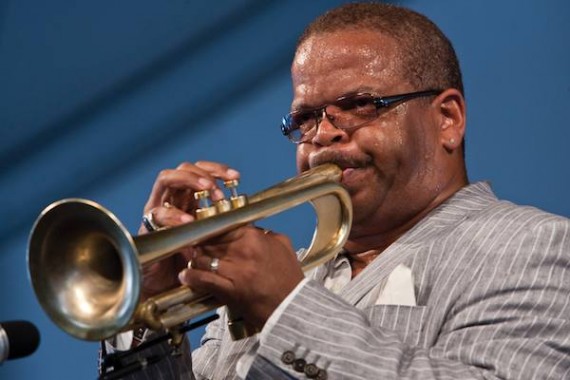The capacity audience at this cosmopolitan Caribbean coastal city’s 15th-annual Barranquijazz Festival fell pin-drop quiet for Terence Blanchard’s opening trumpet soliloquy.
Barranquijazz takes place in Barranquilla, Colombia the second week of September every year. It’s centered on Latin jazz and its perspective is Colombian, but the offerings are multi-generic and the cast is international. Among the notables of last year’s programming were Eddie Palmieri’s irresistible trombanga La Perfecta II, superstar Spanish cantaor Diego El Cigala, up-and-coming Havana pianist Harold López-Nussa, veteran bossa novist João Donato, and Blanchard’s group, which was understood in Colombia to represent for New Orleans.
It did, albeit subtly. Amid all the styles on display at Barranquijazz, Blanchard’s was the one that most spoke for the century-long lineage of jazz, with its broad bottom of New Orleans. An African American trumpeter with a Cuban piano player? Now that’s New Orleans, going back to before there was jazz.
You could make a case for the trumpet as the single most characteristic instrument of jazz, from Buddy Bolden until now, and New Orleans—urban from its beginnings, dense and innovative—was the place where the transformative step was taken. The trumpet was a military signaling tool that had added valves and become part of the dance orchestra, where it developed a radically new, emotively soloistic style. That style incorporated all kinds of sounds previously not considered musical by a more polite world in which “music” was what could be notated on a staff and stored in a piano bench. Once recording became available, an African aesthetic of sound could be written directly in waveforms, and from New Orleans, that un-notatable trumpet style spread out to—and this is not hyperbole—transform the music of the world. As defined to the world at large by Louis Armstrong via the new-born record industry, the trumpet became the emblematic voice of jazz.
New Orleans trumpeters are distinct still. It’s not so easy to say exactly how, but you can hear it. As apart as Blanchard might be from the other familiar names of New Orleans trumpet, there’s something they all have in common, some kind of seal that adds up to a collective individuality. They share a set of common reference points in music history, a hyper-awareness of early jazz that goes back beyond the legacy of Armstrong. They’ve all gigged in the streets where jazz first appeared.
If you wanted to look at Blanchard’s musical genealogy, you could go to his Los Angeles Times mini-interview with Nate Jackson in which he cites New Orleans trumpeter Alvin Alcorn (1912-2003) as “the reason I picked up the trumpet.” If you wanted to be metaphorical about it, you could invoke the ghostly architecture of cedar and ironwork that surrounds the notes—sometimes New Orleans musicians seem to play that ironwork—or the still-standing buildings that were once slave dealers’ showrooms, or the intricate cruelties of a three-caste system, or the intersection of the northern and southern hemispheres with Canal Street as the boundary, or the particular kind of community conversation that music is in New Orleans, or, more directly, the soul-shaping influence of the jazz funeral.
More precisely, there’s something about the speech-like quality with which individual notes are pronounced. The way Blanchard shapes even a single tone tells you he’s from New Orleans, to say nothing of how one note elides into another, the kind of ornamentation that seems appropriate, the easy intensity of the swing, and maybe even in the specific pitch-flavor of the blue notes. Listen to the entry of Blanchard’s trumpet on “Levees”, from his 2007 masterpiece A Tale of God’s Will: A Requiem for Katrina: each note cries out in its own way, each one with a distinct personality, and it all adds up to scream out New Orleans.
But Blanchard doesn’t lock down that easily. A complex, modern American, he carries around a lot that’s not New Orleans. His lifetime of study, travel and experience includes long years in New York, as well as having become one of the best film composers of the last 20 years. But this too is a familiar part of being a New Orleans musician: going out into the larger world, and maybe coming back. Blanchard did that in 2007 when he helped relocate the Thelonious Monk Institute of Jazz Performance program to Loyola University.
When New Orleans was at its peak in the 19th Century, the three great music cities of the hemisphere were tightly interconnected through maritime commerce: Havana, New Orleans and New York. All three towns are still major music capitals, and all three were present in Blanchard’s set I heard in Barranquilla.
The format of Blanchard’s band is the classic jazz quintet, associated with New York more than anywhere else. Born out of bop, it’s fronted by that most recognizable of 20th-Century timbres: the trumpet-and-sax duo, in which complicated scalar passages are subject to the intonational and phrasing vagaries of valves versus keys and the distinct envelopes of brass versus reed, sometimes in unison and sometimes in harmony. As a bandleader, Blanchard bears the stamp of his four years with Art Blakey, for whom he was trumpeter and music director. A Blakey veteran expects a lot from a drummer, and Blanchard has a comfortable playing relationship of seven years’ duration with the 31-year-old Houstonian Kendrick Scott, whose discursive, compositional style seems to complete the improvisers’ thoughts.
Not unlike Blakey, Blanchard mentors exceptional younger musicians—in Barranquilla, 19-year-old bassist Joshua Crumbly and 27-year-old pianist Fabián Almazán. Almazán can play you a danzón with a conservatory touch. He was born in Havana but grew up in New York and studied at the Manhattan School of Music. That triad again: New Orleans, Havana, New York.
When the horns lay out, there’s a convincing, edgy piano trio among Almazán, Crumbly, and Scott. The players are visibly excited to be making their mark in this band. When I asked Almazán who he’d studied with, he named his teachers—among them, Jason Moran and Kenny Barron—but quickly added, “I’m studying with Terence right now. Every night I learn a little bit. I feel like with the first week of playing in his band, I learned more than in six years of school.” The band members have plenty of space in which to be themselves. They’ve played the music so much they don’t have to think about it, so the individual numbers seem to have fused into a single arching, composite piece.
The set at Barranquijazz began with Blanchard’s “Wandering Wonder.” One of his signature tunes, it’s angular and intense, with eruptive, physical solos from Blanchard and tenor player Brice Winston. With a mic mounted on his horn, bell pointed at the floor, Blanchard restlessly paced the stage in profile to the audience, his movements seemingly an inadvertent by-product of the lines he was pulling out of the depths. His stance implied searching, emphasizing his communication with the other players. The number, he told me after the set, recalled for him musicians he knew when he was starting out who for one reason or another never developed their potential, players who hit something that stopped them. For the audience, it was instrumental music, complete and understandable as sound without any story attached; for Blanchard, this piece was a way of holding onto a human memory. He’s an emotive player, which, again, takes us back to New Orleans.
[youtube]http://www.youtube.com/watch?v=NuOMMlktBmo[/youtube]
After an only occasionally recognizable, presto version of “Autumn Leaves” that took the tune’s circle-of-fifths chord changes out of the soft-ballad realm entirely, a buildup of intensity that had been going on for some minutes gave way to a lyrical feature for Almazán that led into the theme of the concert’s emotional centerpiece: Aaron Parks’ composition “Ashé,” from A Tale of God’s Will.
The silence of the people as they listened to that number was electric.
On top of all the other things New Orleans is, the world now knows it as a memorial site. But New Orleans was already a memorial site when Buddy Bolden first sang “Funky Butt.” Its sacred, silty ground was populated with the hovering souls of unquiet dead whose spirits can be distilled into music by skilled, committed artists.
When Blanchard drops that number into the middle of the touring set, it means that out there on the road, he is lighting his candle for New Orleans. Whether or not he thinks of it that way is almost beside the point. If you only heard the intellectual play of Blanchard’s jazz, you heard as good a set as you can ask for. But the audience knew that the tune was part of a Katrina requiem—some because they’d heard A Tale of God’s Will, and some because the emcee had prominently mentioned it in his introduction.
I say Blanchard wasn’t only playing to the 949 people packed into the Amira de la Rosa Theater, who knew a spiritual moment when they heard one. As a godmother of Santiago de Cuba’s tumba francesa once said to me, “It’s not only we the living who are dancing.”
That voice that comes out of Blanchard’s horn? It reaches back to before he was born.
I’m a witness that they were feeling it in Barranquilla.
Terence Blanchard plays Jazz Fest with Poncho Sanchez and his Latin Jazz Band on Friday, April 27 at 5:30 p.m. on the Zatarain’s/WWOZ Jazz Tent.





